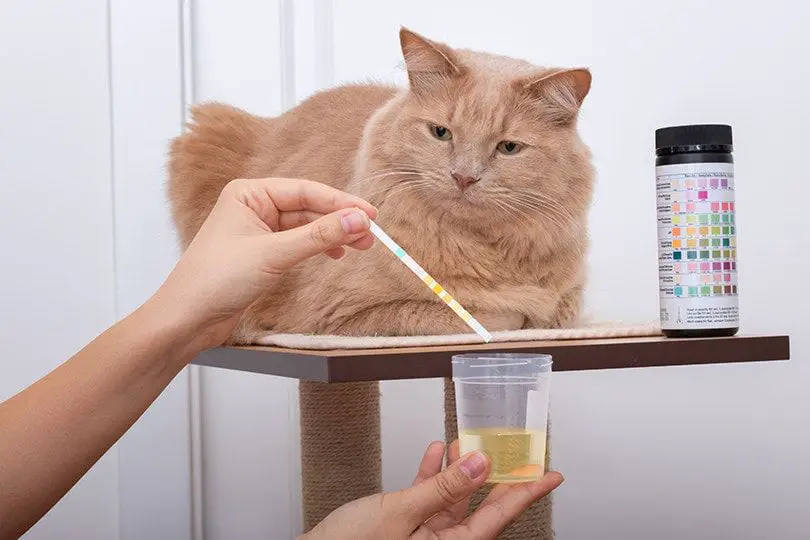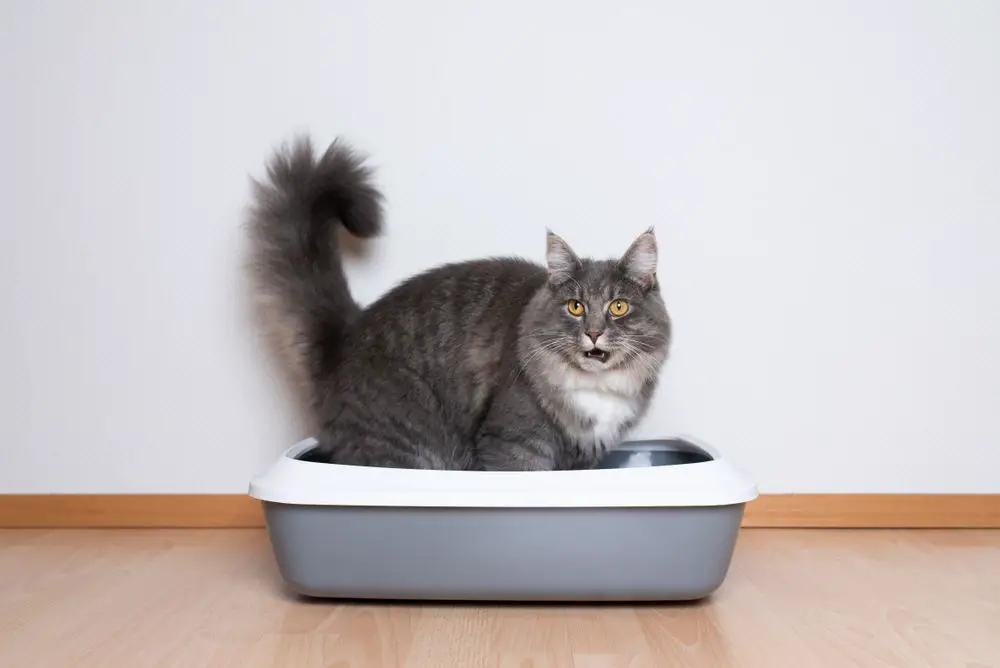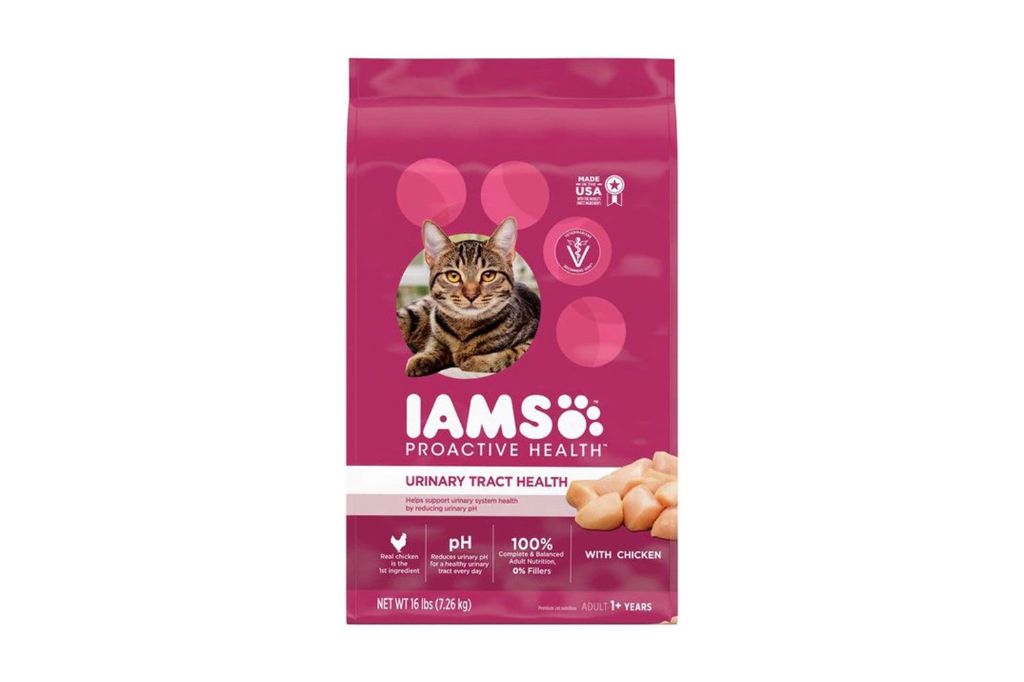Cat urine crystals are small mineral formations that can develop in a cat’s urine. Being able to identify crystals in cat urine is important because certain types of crystals can clump together and cause painful urinary blockages. Left untreated, this can become a life-threatening condition for cats.
Crystals form due to imbalances in the chemical makeup of a cat’s urine. While some crystals are relatively harmless, others like struvite and calcium oxalate warrant further testing and treatment. Catching crystals early allows vets to identify and address any underlying issues before they progress.
This article will provide an overview of the different types of cat urine crystals, what they look like, causes and risk factors, diagnostics, potential complications, and prevention methods. Being able to identify potential crystals at home is the first step in getting cats the treatment they need.
What Are Cat Urine Crystals?
Cat urine crystals are collections of mineral compounds like calcium oxalate, struvite (magnesium ammonium phosphate), or urate that form solid particles in a cat’s urine (VCAAnimal Hospitals, 2023). Normally, these minerals dissolve freely in a cat’s urine. However, when certain conditions cause the urine to become too concentrated or too alkaline, the minerals can precipitate out as crystals.
Crystals in cat urine, also called crystalluria or urolithiasis, are a common condition especially in male cats. Though crystals may occasionally form in healthy cats with no issues, they are often a sign of an underlying problem. Crystals can irritate the urinary tract, block the flow of urine, and lead to more severe complications if left untreated (PetMD, 2023).
Crystals in cat urine come in different shapes and colors. Struvite crystals are large, “coffin-shaped” crystals that form in alkaline urine. Calcium oxalate crystals appear as small, diamond-shaped, envelope-shaped or dumbbell-shaped crystals often in acidic urine. Urate crystals form in acidic urine and can appear yellow, orange or reddish-brown (PetMD, 2023).

Causes of Crystal Formation
There are several conditions that can lead to the formation of crystals in a cat’s urine:
One of the most common is feline lower urinary tract disease (FLUTD), which is a condition that causes inflammation of the bladder and urinary tract. FLUTD makes cats prone to developing crystals as it alters the chemical balance of the urine. Factors like stress, diet, and lack of hydration can trigger or exacerbate FLUTD (1).
Bladder stones are another common cause of crystals. Bladder stones form when minerals crystallize in concentrated urine and clump together into stones. They irritate the bladder wall, often leading to significant crystal formation as well (2).
Urinary tract infections caused by bacteria can also increase the likelihood of crystal formation. The bacteria impact the chemical makeup of the urine, making it more conducive to crystallization (3).
Finally, stress is thought to play a role. When cats are stressed, they often urine mark more frequently in smaller amounts. This leads to more concentrated urine, which allows crystals to form more readily.
Consult with your vet if your cat is prone to any of these conditions to help prevent recurring crystal formation.
Types of Crystals

There are several types of crystals that can form in a cat’s urine, the most common being struvite, calcium oxalate, and urate crystals:
Struvite crystals: Also known as magnesium ammonium phosphate crystals, struvite crystals are usually large, hexagonal crystals that form in alkaline urine (pH > 7). They often form as a result of urinary tract infections caused by bacteria that split urea into ammonia, raising the pH of the urine (VC Animal Hospitals).
Calcium oxalate crystals: These crystals form in acidic urine (pH < 7) and appear as small envelopes or dumbbells under a microscope. They can form as a result of increased calcium in the diet, kidney disease, or other metabolic conditions (PetMD).
Urate crystals: These crystals form when uric acid levels are elevated in the body. They appear yellowish-brown and grainy under a microscope. Urate crystals can indicate liver disease, cancer, or a genetic predisposition in some cat breeds.
Identifying the type of crystals present in your cat’s urine can help determine the underlying cause and best treatment approach.
Identifying Crystals
There are a few common types of crystals that may form in a cat’s urine:
Struvite Crystals
Struvite crystals are one of the most common types of crystals found in cat urine. They form in alkaline urine and often look like small coffeecubes. Struvite crystals can appear white, tan, or light brown. They have a rectangular prism shape with pyramid-like ends.[1]
Calcium Oxalate Crystals
Calcium oxalate crystals develop in acidic urine. They resemble tiny envelopes or squares with an “X” through the middle. These crystals are colorless and transparent.[2]
Ammonium Urate Crystals
Ammonium urate crystals occur when urine pH is too alkaline. They look like yellow-brown spheres or spiky balls under a microscope. These crystals may indicate liver disease.[1]
Cystine Crystals
Cystine crystals are rare and linked to a genetic disorder in some cats. They are hexagonal (six-sided) plates that stack on top of each other. The crystals have a yellow-white color.[3]
Looking at the color, shape, and structure of the crystals under a microscope can help identify the type present in your cat’s urine. This guides appropriate treatment and prevention methods.
[1] https://betterpet.com/crystals-in-cat-urine/
[2] https://betterpet.com/crystals-in-cat-urine/
[3] https://vcahospitals.com/know-your-pet/struvite-bladder-stones-in-cats
Diagnosing Crystaluria
If a cat is suspected of having crystals in their urine, a veterinarian will perform diagnostic tests to confirm.
A urinalysis is usually the first test performed. The veterinarian will collect a urine sample and examine it under a microscope to look for the presence of crystals. Different types of crystals have distinct shapes that can be identified during urinalysis (PetMD).
Imaging tests may also be recommended to get a better view of the bladder and look for stones. X-rays or ultrasound can reveal bladder stones and mineral deposits that may not be obvious from a urine sample alone. These imaging techniques allow the vet to determine the number, size, and location of any bladder stones (Rawz Natural Pet Food).
Bloodwork may also be performed to assess kidney function and look for any metabolic issues contributing to crystal formation.
With these diagnostic tests, vets can definitively diagnose crystaluria and identify the type of crystals present so appropriate treatment can be determined.
Potential Complications
Crystalluria can potentially lead to some serious complications in cats if left untreated. One of the most common is feline lower urinary tract disease (FLUTD), which occurs when crystals build up and cause irritation, inflammation, or blockages in the urinary tract (Source). Signs of FLUTD include frequent and painful urination, blood in the urine, straining to urinate, and frequent licking of the genital area.

In male cats especially, the narrow urethra can become completely blocked by crystals and mucus plugs. This painful condition, called a urethral obstruction, can quickly become life-threatening and requires emergency veterinary treatment (Source). Signs include crying in pain, very frequent attempts to urinate, and lethargy.
Over time, the presence of crystals can also lead to more chronic urinary tract infections, tissue damage, or kidney problems. Struvite crystals in particular can promote bacterial growth in the urinary tract. Kidney damage can occur from persistent obstruction or high mineral concentrations (Source). That’s why it’s so important to address crystalluria promptly.
Treatment
The primary treatment for cat urine crystals is typically a combination of dietary modification, increased water intake, and medications when needed (Source: https://vcahospitals.com/know-your-pet/crystalluria-in-cats).
Veterinarians often recommend switching to a therapeutic diet formulated to promote the proper pH balance in a cat’s urine. These prescription diets help prevent crystal formation by altering the chemical composition of the urine (Source: https://vcahospitals.com/know-your-pet/struvite-bladder-stones-in-cats). Increasing water consumption can also help dilute the urine and flush out any existing crystals.
Medications may be prescribed to manage any underlying conditions contributing to crystal formation, such as urinary tract infections. Antibiotics can treat infections while drugs like methioprim may inhibit crystal growth (Source: https://bluebuffalo.com/articles/cat/crystals-in-cat-urine-and-how-to-treat-them/).
In severe cases, surgery may be required to remove large bladder stones if they do not dissolve with dietary and medical therapy. However, most cats can be successfully treated with less invasive approaches.
Prevention
There are several ways to help prevent the formation of crystals in your cat’s urine:
Diet
Feeding your cat a prescription urinary or kidney diet can help prevent crystals. These diets are formulated to produce urine that is not conducive to crystal formation by controlling urine pH, providing optimal levels of magnesium, and reducing compounds that can lead to crystal development.

Exercise
Making sure your cat gets regular daily exercise can help increase water consumption and bladder emptying, which helps flush out any crystals or debris before they aggregate into stones. Try interactive toys and daily playtime.
Stress Reduction
Reducing stress through environmental enrichment, routine, and minimizing change can help prevent urine crystal formation. Stress causes physiological changes that can make cats prone to crystals.
Water Intake
Encouraging increased water intake dilutes the urine and makes crystal formation less likely. Provide multiple fresh water sources, consider a cat water fountain, and feed wet food.
When to See a Vet
If your cat is exhibiting any signs of lower urinary tract disease or crystal formation, it’s important to schedule a veterinary visit right away. Some key signs to watch for include:
- Straining or crying out while trying to urinate
- Frequently visiting the litter box but only passing small amounts of urine
- Blood in the urine
- Excessive licking around the genital area
- Urinating outside of the litter box
According to the VCA Hospitals website, “Straining to urinate and blood in the urine are signs that the crystals have caused an obstruction in the urethra [the tube that carries urine from the bladder]. This obstruction prevents urine outflow and it is a life-threatening emergency requiring immediate veterinary care.”1
If any symptoms last for more than 24 hours or seem to be getting worse, don’t wait – contact your vet right away. Catching urinary issues early can help prevent potentially serious complications like blockages, infections, and bladder or kidney damage.

